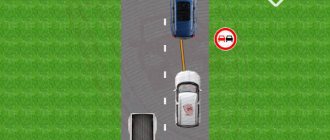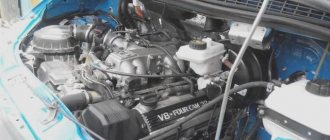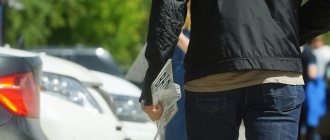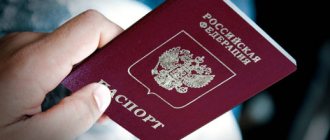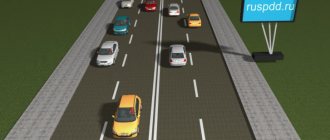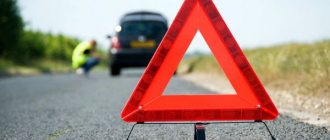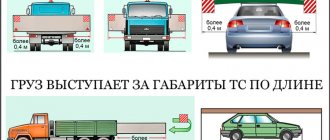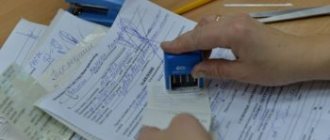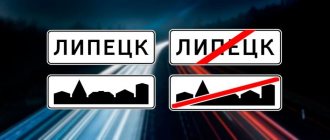AutoUrayt.rf / Questions
Back
Published: March 15, 2019
Reading time: 5 min
0
1150
Stopping a vehicle by a traffic police inspector is already an unpleasant situation that can throw the driver off balance. And conducting an inspection is a good reason for stress! How to behave? What laws to operate with? How is the procedure performed? To what extent do the powers of traffic police officers extend? These and many other issues will be addressed in the article, after reading which any driver will be able to protect his rights while acting within the law.
- The procedure for conducting a vehicle inspection by a traffic police officer
- The main differences between a search and a car inspection
- Grounds for inspection
- The procedure for stopping the vehicle
- Search for witnesses and release of the vehicle interior
- Direct inspection
- Drawing up a protocol
- Witnesses or video recording
- Inspector's responsibility
The procedure for conducting a vehicle inspection by a traffic police officer
All actions of traffic police officers performed in relation to drivers and vehicles are regulated by law. The main regulations that both parties - the driver and the inspector - can refer to in the event of a dispute include:
- Administrative regulations approved by Order of the Ministry of Internal Affairs of the Russian Federation No. 664 of August 23, 2017
- Code of Administrative Offenses of the Russian Federation
The search is also carried out in compliance with the articles of the listed laws . But it is possible that both parties to the procedure may interpret them in their own way, making mistakes and violations.
Inspectors rarely conduct inspections of vehicles, in most cases limiting themselves to checking documents. But drivers must be prepared for a different turn of events, which means they must know well how the search is carried out and how to protect their rights if an official openly exceeds his authority. After all, refusing or obstructing an inspection can entail serious consequences - arrest for up to 15 days (Part 1 of Article 19.9 of the Administrative Code).
Car trunk search
Inspection of the trunk is part of the vehicle analysis, that is, a separate procedure is not carried out regarding individual components of the car.
In practice, traffic police officers often require drivers to show the contents of the trunk. However, they do not formalize the event as an inspection event. In fact, they have the right to do this if the driver agrees, but only as part of the inspection, that is, without penetration or any contact with the contents. Otherwise, it is necessary to call witnesses or turn on the video recording and document everything in accordance with the established requirements.
In general, when the trunk is analyzed, an inspection of the vehicle is carried out. It is also necessary to fill out a protocol and carry out other activities.
The main differences between a search and a car inspection
Inspection or inspection? For most motorists, the differences in these concepts are insignificant or completely unnoticeable. But from the point of view of the law (Administrative Regulations approved by Order of the Ministry of Internal Affairs of the Russian Federation No. 664 dated August 23, 2017), the difference between them is significant. It's easier to track it in a table.
| Procedure name | Characteristic | |||||
| Formulation | Driver's consent | Exit from the passenger compartment for the driver and passengers | Examination of personal belongings in the car | Availability of grounds | Protocol | |
| Inspection | Visual examination of the vehicle without entering inside | + | — | — | — | — |
| Search | Actual content control | — | + | + | + | + |
In addition to the above wording of the actions of authorized persons when stopping a car, there is another one - “search” . The Law “On the Police” states that as part of these manipulations, the inspector can independently touch and move things inside the vehicle and violate its integrity . But the search is preceded by:
- Initiation of a case
- Issuance of the relevant resolution
If an inspector classifies his actions as an inspection, but independently opens the bags in the car, lifts the seats, opens the hood, and so on, then he violates Art. 27.9 of the Code of Administrative Offenses of the Russian Federation and may be punished with a fine of 20,000 rubles.
Protocol
Administrative Regulations of the Ministry of Internal Affairs No. 664 contain the obligation of a traffic police officer to draw up a protocol on the inspection of a vehicle. At the same time, it is permissible, instead of drawing up a separate document, to make a note about the search in the arrest report if it was drawn up on the spot.
The protocol must indicate:
- date, time, place of compilation. For the reader’s information, State Traffic Inspectorate employees can inspect a car anywhere, not only at the traffic police post. At the same time, the car in which the patrol travels must be equipped with identification marks - in other words, flashing lights and the corresponding inscription “DPS”. If there are no identification marks, such employees are not given the right to stop and, especially, to carry out procedural actions;
- personal data of the person who owns the car;
- position and special rank, full name of the police officer;
- information about the vehicle – make, license plate, VIN;
- detailed information about the items that were discovered during the inspection - type, type, quantity of prohibited items, packaging - weapons, drugs, etc.; number and title of documents;
- a note on video or photography, as well as audio recording, if it was made during the inspection process;
- the presence of signatures of the persons involved - first of all, the official who drew up the procedural document, as well as witnesses, the owner of the transport. The purpose of such a requirement is to verify the correctness of the drafting. If the driver (or owner) of the vehicle refuses to sign, the official makes a note about this. Witnesses do not have the right to refuse to sign, since recording and verifying the event is their direct responsibility.
In practice, questions arise as to who signs the protocol if both the driver and the owner of the vehicle are present. In such situations, the driver is most often involved in drawing up the document if their actions contain signs of an administrative offense. If there are no such signs, the owner may also be involved in the inspection procedure and the preparation of the necessary documentation.
What are the consequences of the absence of one of the listed items in the document - for example, if the position of a State Traffic Inspectorate employee is not indicated? This question cannot be answered unequivocally. Of course, this is a violation of the procedure, but often omissions of the formal order are recognized by the courts as not so significant and influencing the invalidation of the protocol as a whole. So, if you forgot to enter information about the license plate number, but the resolution on the administrative offense contains this data, such a defect cannot be considered significant. But the absence of information about witnesses in the protocol almost always entails the recognition of the protocol as illegal, as well as the absence of a signature of any of the participants (except for the situation when there is a note about the driver’s refusal to certify what happened).
Pay attention to the sample protocol, which is provided for by the current regulations of the Ministry of Internal Affairs (Appendix No. 12):
PROTOCOL 00AA333333
About vehicle inspection
“December 15, 2021 "16" hour. "30 min. Volgograd
(date and time of compilation) (place of compilation)
I, IDPS traffic police department of internal affairs of Volgograd, senior police lieutenant Minin R.G.
(position, special rank, unit, surname, initials of the official who compiled the protocol)
In accordance with Art. 27.9 of the Code of the Russian Federation on Administrative Offenses / clause 16 of part 1 of article 13 of the Federal Law “On Police”, I compiled this protocol that in the presence / absence of a citizen
| B | E | Sh | N | ABOUT | IN | E | G | ABOUT | R | IN | L | A | D | AND | M | AND | R | ABOUT | IN | AND | H |
(last name) (first name) (patronymic if available)
Born 11/12/1995, native of Volgograd,
living at the address: Volgograd, st. Stroiteley, 81, apt. 33, phone: 8913331111111,
(residence address, phone number if available)
working as a senior driver-forwarder for Products-Volga LLC, legal address: Volgograd, st. Tsvetnaya, 9 "A", tel/fax,
(name and address of the organization, telephone, position)
who owns the vehicle: type - light truck, GAZelle brand, model, GAZ-322132
state registration plate B 077 RP 34 RUS, VIN YРМH223444454888, engine N YРМH223444454888
December 15, 2021 at 16:50 at the traffic police post in the village of TRAVINSKY,
(date, time, place of vehicle inspection)
if there are reasons (cross out what is not necessary):
— checking a reasonable assumption about the presence in a vehicle of weapons, ammunition, ammunition for weapons, explosives, explosive devices, narcotic drugs, psychotropic substances or their precursors or toxic or radioactive substances;
— checking a reasonable assumption about the presence of instruments or objects of an administrative offense in the vehicle,
carried out an inspection of the specified vehicle.
During an inspection of the vehicle, the following were found: 3 cartridges (20 caliber), 1 Saiga hunting carbine, no license
(type, quantity, other identification features of things, type, brand, caliber, series, number, other identification features of weapons, type and quantity of ammunition, type and details of documents found during inspection, presence of damage, their location, size and nature, other traces of an administrative offense).
During the inspection, photography, filming, video recording, and other established methods of recording material evidence were used (cross out what is not necessary)
using a CANON 112233 series camera, produced in 2021.
(indicate technical means of photography, filming, video recording, and other method of recording material evidence).
The protocol is accompanied by a CANON-12 flash drive with photographic results.
If an inspection of a vehicle is carried out in the absence of the person in whose possession it is located, indicate the reason ________________________________
(in urgent cases).
The inspection of the vehicle was carried out in the presence of witnesses, who were explained their rights and obligations under Article 25.7 of the Code of the Russian Federation on Administrative Offences/with the use of video recording (cross out what is not necessary):
Witnesses: 1. Last name Pashnova first name Elena patronymic Ivanovna (if any), residential address Volgograd, st. Minskaya, 26, apt. 13, telephone 891116565656, signature
- Last name Maksakov first name Peter patronymic Stepanovich (if available), residential address Volgograd, st. Melnikova, 123, apt. 2, phone 89083232323, signature
Signature of the person in whose possession the vehicle subjected to inspection is located (in case of refusal - a record of his refusal to sign the protocol): Beshnov E.V.
Signature of the official who compiled the protocol: Minin R.G._________
A copy of the protocol was received by: Beshnov E.V. (signature of the person in whose possession the vehicle subjected to inspection is located).
From the presented sample it follows how important it is to indicate in the protocol the identification data of items discovered during the examination - after all, subsequently the fact of discovery of items prohibited for circulation may entail other liability, including criminal liability. The legality of the stage of collecting primary material can hardly be overestimated - if the law is violated at this stage, evidence collected subsequently may be declared inadmissible.
Thus, after an inspection, items of an administrative offense or crime may be confiscated. For example, if devices with red lights are found on the front of the car (an offense falling under Part 3 of Article 12.5 of the Code of Administrative Offenses of the Russian Federation), these devices are subject to forced confiscation after inspection. It is obvious that the indication in the protocol of the quantity, quality of these items and their location on the vehicle must be accurate and correct.
Example No. 4 . During the inspection, the traffic police inspector discovered invalid state registration numbers on the car, which is punishable under administrative law in accordance with Part 3 of Art. 12.2 Code of Administrative Offenses of the Russian Federation. In this case, fake license plates are subject to seizure in a separate protocol, but first an inspection protocol is drawn up, in which it is extremely important to correctly record the data on the items.
Strict requirements also apply to the mandatory indication in the protocol of one of the grounds giving the policeman the right to search vehicles. In this case, the standard form is designed in such a way that the inspector only needs to select the required basis, crossing out the irrelevant one.
A copy of the protocol must be given to the owner of the inspected vehicle. Sometimes officials “forget” to give the document to the driver. If this happens to you, politely remind the inspector that you have the right to receive a copy.
Grounds for inspection
This moment in the entire procedure raises the most questions. The main thing that the driver must remember is that the inspector’s words, not supported by documents, will not be grounds for inspection . This behavior is a direct violation of Art. 27.9 of the Code of Administrative Offenses of the Russian Federation and Order 664.
More on the topic: Checking the trunk of a car by a traffic police inspector: in what cases is it legal and necessary?
The traffic police officer does not have the right to conduct an inspection at his own discretion . Legitimate reasons for checking a car will be:
- Availability of orientation for this vehicle
- Detention of persons in a car (Part 2 of Article 14 of Law 3-FZ of 02/07/2011 “On the Police”)
- Checking the information received about the participation of a car in a crime or offenses of various nature (information can be sent from traffic police posts, road users and more)
- Confirmation or refutation of data on the presence in the vehicle of objects with the help of which it is possible to commit an offense
- Checking information on the transportation of weapons, poisons and other dangerous substances
Previously, refusal to inspect a car became a reason for conducting a thorough search without the consent of the car owner. But in 2021, in the new reading of the regulations, such an item in the list of grounds does not exist.
Before starting the inspection, the driver has the right to check all the reasons given by the inspector by calling the duty station. The traffic police officer must provide the required telephone number.
If an authorized person deliberately detains the owner of a vehicle without carrying out the search procedure, despite notification of its beginning, the driver can immediately complain about unlawful actions by calling the duty station or any police department.
The reason for inspection cannot be the announced “Interception” plan. In peacetime, it only serves as a reason to stop the vehicle and check documents. But in wartime or in the event of martial law being introduced in the country, this is quite enough for a thorough inspection of any car.
Which employees have the right to conduct searches?
The process must be carried out strictly in accordance with the procedure established by law. This applies not only to the procedure for conducting and recording the result, but also to the persons who carry out actions when a vehicle inspection situation arises.
In paragraph 2 of Article 27.9 of the Code of Administrative Offenses of the Russian Federation there is a reference to persons who have the appropriate authority. They are specified in Articles 27.2 and 27.3 of the Code of Administrative Offenses of the Russian Federation, that is, the law establishes that the search of a car is carried out by the same officials who carry out the administrative detention or delivery of a person. These include:
- employees of the Ministry of Internal Affairs;
- employees of the military automobile inspection or the executive body exercising relevant control;
- border and customs officials;
- employees who implement an operation aimed at countering terrorism;
- FSSP employees;
- military police.
If an accident occurs or if appropriate suspicions arise, traffic police officers have the right to inspect the vehicle. Traffic police inspectors who conduct patrols and are located at special posts have similar powers.
Procedure
According to the Administrative Regulations approved by Order of the Ministry of Internal Affairs of the Russian Federation No. 664 dated August 23, 2017 and the Code of Administrative Offenses of the Russian Federation, in the legal field the inspection procedure will look like this:
- Car stop
- Presentation of documentary grounds for stopping and searching
- Search for 2 witnesses
- Emptying the vehicle interior by the driver and passengers
- Thorough inspection of the vehicle by an inspector, including the trunk and cargo
- Drawing up a protocol on the procedure performed
- Signature left by both parties
- Transferring a copy of the protocol to the driver
It seems that everything is extremely simple and there should be no questions, let alone disputes regarding the inspection procedure. But in practice, both car owners and inspectors make mistakes during inspection. Therefore, some items from the above list will be discussed in more detail.
Vehicle stop
The traffic police officer on duty has every right to stop the car near the checkpoint and in any other place - in the city and beyond. At the same time, he can wave not only the wand, but also his hand. In both cases, the driver must stop.
More on the topic: Is it possible to put a dog guard on a car?
The exception is situations when the inspector calls for stopping in places where this is prohibited by markings or road signs.
When the stop is made, the driver can calmly wait for the traffic police officer, who is obliged to:
- Introduce yourself verbally
- Provide reason for delay
The vehicle owner may request an inspector's certificate, which is provided upon request. Of greatest interest in the document are:
- Number
- FULL NAME. the official who made the stop
The listed data can be copied into a notepad. It is prohibited to photograph them .
Search for witnesses and release of the vehicle interior
The following cannot be witnesses:
- Passengers of a stopped car
- Traffic police officers
The inspector must appoint witnesses from random passers-by or stop another car for this purpose. Uninterested persons must provide the traffic police officer with identification cards, the data from which will be entered into the protocol.
Vehicle inspection is carried out only if the interior is empty . The driver and passengers are required to get out of the car, but be present during the procedure and facilitate its implementation within the legal framework. In this case, it is permissible to video and photograph the process.
Direct inspection
Here inspectors often exceed their powers. Therefore, any driver should know that:
- The official cannot touch personal belongings with his hands, open the trunk, hood and glove compartment - at his request, all such actions are performed by the owner of the vehicle
- Sealed cargo cannot be opened - it is reported by radio to the duty station and only after receiving the appropriate orders (this is done in the most extreme case, when there is a direct threat to life) the integrity of the seal is broken
- The squad officers do not prevent the driver from being near his car, but in case of suspicion that he has committed a criminal offense, they have the right to partially restrict his freedom (with handcuffs)
- If an administrative offense or other crime (committed or planned) is detected during the inspection, the inspector draws up a corresponding document.
In the first case, it will be a case of offense opened by the traffic police officer himself. In the second, a report is transmitted to the investigative team sent to the inspection site by calling the duty station.
Drawing up a protocol
Based on the results of the inspection, the authorized person draws up a protocol. It states:
- Inspector details: Full name, title, position
- Place and date
- Details of the person driving the vehicle: full name, date of birth, number and date of issue of driver’s license, place of registration, residential address, telephone
- Vehicle identification features
- Details of witnesses: full name, date of birth, place of registration, residential address, telephone
The protocol sets out in detail the procedure for conducting the search and the material evidence discovered during it (they must be photographed and printed out attached to the document) of the guilt of the vehicle owner in the criminal actions charged to him.
More on the topic: Is it possible not to sign the protocol and resolution of the traffic police?
The protocol must be handed over to the interested party for review. If he disagrees with any of the information presented, he has the right to refuse to sign the document.
Refusal to leave a signature must, according to the regulations, be reflected in the protocol. In any case, the driver receives a copy of the paper.
The procedure may be accompanied by the confiscation of any items from the owner. This fact and a list of things must be included in the protocol. If this is not done, the driver must point out the omission to the inspectors. Witnesses must also be present during the communication between the inspector and the person driving the vehicle.
Witnesses or video recording
It happens that the inspector refuses to look for witnesses, citing official video recording. Such actions cannot be classified as lawful. The law does not oblige traffic police officers to film the search. It is permissible to carry it out on their own initiative by both parties. But the presence of witnesses is a prerequisite for the legality of the search . Therefore, the driver must insist on their presence.
In a situation where the search is carried out in a deserted place and searching for witnesses is not possible, the driver must agree to official video recording.
Witnesses during a car search
The process of inspecting a car by a traffic police inspector is always carried out either in the presence of witnesses or using video recording (except in urgent cases).
The concept of “witness” is specified in Article 25.7 of the Code of Administrative Offenses of the Russian Federation. The norm states that such a person can be any person with certain characteristics. It should be:
- capable;
- adult;
- not interested in the result.
The participation of witnesses is recorded in the protocol. The document indicates their details. During the consideration of the case, they can be involved as witnesses, since they have the necessary information and information.
The witness can give his comments regarding the actions being taken. If he does not agree with the information reflected in the car inspection protocol, he can make a corresponding note in the document.
In fact, the presence of witnesses is necessary to confirm the actions carried out by traffic police officers, as well as to confirm other information, including the actions of the citizen who is being searched. These are neutral persons who are not interested in the outcome of the review and do not belong to any party.
Violations that traffic police officers may commit during an inspection
Some inspectors intentionally or unintentionally commit a number of violations during the procedure. Often they are left without recording by the driver, since he himself does not fully understand how exactly the inspection should take place.
The most common errors are:
- Lack of witnesses
- Removal of the vehicle owner from participation in the process
- Independently shifting things, which is already classified as a search
- Refusal to review the protocol
- Requirement to sign the protocol without prior review
- An order to put things out of the trunk
The second party to the inspection has the right to point out violations to the inspector in a polite manner and record it on video.
Inspector's responsibility
If a traffic police officer does not carry out the proper actions, but makes mistake after mistake, then there is no point in arguing with him. All violations can be recorded and included in a complaint within 10 days.
When considering it, officials will be guided by Article 19.1 of the Code of Administrative Offenses of the Russian Federation. If the complaint is confirmed, the inspector will be fined 20,000 rubles.
Vehicle inspection
The concept of TTS in its consequences and significance can be comparable to a search; unauthorized persons gain almost uncontrolled access to your things or cargo, and this can have very negative consequences for you. Therefore, it is very important to protect yourself as much as possible.
Any access to the car, to its trunk, to the belongings of the driver or passengers of the vehicle must be made only if there are compelling reasons and in compliance with the administrative inspection procedure. Interfering with legal traffic regulations is prohibited.
Recommendations for the driver
In any situation, the road user is recommended to:
- Follow orders of traffic police officers
- Keep calm
- To be polite
- Take an active part in all manipulations performed with the car
- Capture what's happening on video
- Take contact details of witnesses and witnesses
Unpleasant situations often arise on the road. But the driver who knows his rights and does not break the law will be able to solve any problem within the legal framework.
Search and inspection, what's the difference?
Most often, the question about the legality of this procedure arises for the driver of the car when the car is stopped by a policeman and, after checking the documents, demands access to the trunk.
At the same time, the inspector states that he needs to inspect the vehicle and insists on the legality of his demand.
But does the examination of a car trunk fall within the parameters of such an administrative procedure as a vehicle inspection? Legislation in the field of road safety supervision gives a clear answer - no!
Inspection of the trunk as a procedural action is impossible.
Search procedure
The inspector, having identified an administrative offense, is obliged to demand that the driver and passengers get out of the car and must inform that an inspection of the vehicle will now be carried out with the involvement of witnesses or without them (with video recording).
Video recording must be made by a certified device that ensures that the original recording is included in the inspection protocol. A police officer is prohibited from filming a procedural action with a camera on his personal phone and then using copies of this recording.
Next, the police officer attracts witnesses (these should be uninterested persons who have an identity card with them). The traffic police officer writes down the data of the witnesses in the protocol, reads them their rights and obligations, and only after that begins the DTS.
During the inspection, the presence of the vehicle owner is required (except in emergency cases).
The data obtained during the inspection is entered into a protocol, and a copy of this document is given to the owner.
